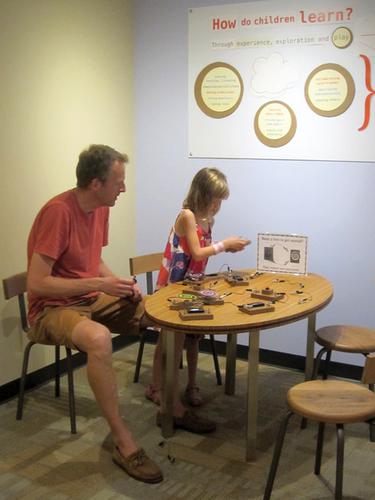Our official English website, www.x-mol.net, welcomes your feedback! (Note: you will need to create a separate account there.)
Relations between parent–child interaction and children’s engagement and learning at a museum exhibit about electric circuits
Developmental Science ( IF 4.939 ) Pub Date : 2020-10-27 , DOI: 10.1111/desc.13057 David M. Sobel 1 , Susan M. Letourneau 2 , Cristine H. Legare 3 , Maureen Callanan 4
Developmental Science ( IF 4.939 ) Pub Date : 2020-10-27 , DOI: 10.1111/desc.13057 David M. Sobel 1 , Susan M. Letourneau 2 , Cristine H. Legare 3 , Maureen Callanan 4
Affiliation

|
Play is critical for children's learning, but there is significant disagreement over whether and how parents should guide children's play. The objective of the current study was to examine how parent–child interaction affected children's engagement and problem‐solving behaviors when challenged with similar tasks. Parents and 4‐ to 7‐year‐old children in the U.S. (N = 111 dyads) played together at an interactive electric circuit exhibit in a children's museum. We examined how parents and children set and accomplished goals while playing with the exhibit materials. Children then participated in a set of challenges that involved completing increasingly difficult circuits. Children whose parents set goals for their interactions showed less engagement with the challenge task (choosing to attempt fewer challenges), and children whose parents were more active in completing the circuits while families played with the exhibit subsequently completed fewer challenges on their own. We discuss these results in light of broader findings on the role of parent–child interaction in museum settings.
中文翻译:

亲子互动与孩子在博物馆的参与和学习之间的关系有关电路的展览
游戏对于孩子的学习至关重要,但是在父母是否以及如何指导孩子的游戏方面存在很大的分歧。本研究的目的是检验当面临类似任务挑战时,亲子互动如何影响孩子的参与和解决问题的行为。美国的父母和4至7岁的孩子(N = 111 dyads)在儿童博物馆的互动电路展览中一起玩。我们研究了父母和孩子在摆放展览材料时如何设定和实现目标。然后,孩子们参加了一系列挑战,其中包括完成越来越困难的赛道。父母为他们的互动设定目标的孩子表现出较少的挑战任务参与度(选择尝试更少的挑战),而父母更积极地完成巡回赛,而与展览一起玩的家庭则随后自己完成挑战的孩子较少。我们将根据有关亲子互动在博物馆环境中作用的更广泛发现来讨论这些结果。
更新日期:2020-10-27
中文翻译:

亲子互动与孩子在博物馆的参与和学习之间的关系有关电路的展览
游戏对于孩子的学习至关重要,但是在父母是否以及如何指导孩子的游戏方面存在很大的分歧。本研究的目的是检验当面临类似任务挑战时,亲子互动如何影响孩子的参与和解决问题的行为。美国的父母和4至7岁的孩子(N = 111 dyads)在儿童博物馆的互动电路展览中一起玩。我们研究了父母和孩子在摆放展览材料时如何设定和实现目标。然后,孩子们参加了一系列挑战,其中包括完成越来越困难的赛道。父母为他们的互动设定目标的孩子表现出较少的挑战任务参与度(选择尝试更少的挑战),而父母更积极地完成巡回赛,而与展览一起玩的家庭则随后自己完成挑战的孩子较少。我们将根据有关亲子互动在博物馆环境中作用的更广泛发现来讨论这些结果。



























 京公网安备 11010802027423号
京公网安备 11010802027423号